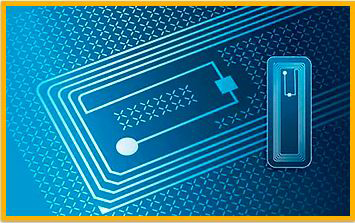RFID (Radio Frequency Identification)

RFID (Radio Frequency Identification)
What is RFID?
RFID is implemented using radio waves to communicate information between a unique item and a system. A typical RFID system consists of an RFID reader, tags (chips), and at least one antenna. RFID systems can be either active or passive. Active RFID tags contain a battery and periodically transmit info with much greater range than passive tags. Passive tags are powered by electromagnetic induction via the RFID reader. Once the tag is powered by the reader, it responds by transmitting its unique information.
How can RFID help you?
RFID has many advantages over barcodes, but barcodes have become a standard in many industries for many worthwhile reasons. Depending on the application, either system will have its strengths and weaknesses. When it comes time for you to make a decision between either system, keep the initial and recurring costs in mind, as well as the potential return on your investments. In years past, implementing a full-scale RFID system was cost prohibitive for small to mid-size companies, but today, the difference in the cost of a new barcode system versus an RFID system may be minimal in certain applications. Also, investing in an RFID system may pay for itself over time due to potential increases in efficiency and decreases in errors.
RFID doesn't need line of sight
For a barcode to be read, the scanner must be placed directly in front of each label, and both need to be oriented in a very specific position in order to work properly. RFID tags on the other hand, don’t need to be directly in sight of an RFID reader. Because RFID uses radio waves to communicate, RFID tags only need to be within the read range of the reader, which will vary depending on the equipment.
An RFID tag is read/write
A barcode can only be read, and the data can never be changed once it has been printed onto a label. RFID tags can be read, and the data on the tag can be rewritten or modified as needed.
RFID tags are durable and reusable
Because barcodes are typically printed on paper labels or other unprotected surfaces, they are easily damaged and rendered unreadable. Depending on your application, you can find RFID tags specifically designed to work in harsh conditions. A durable hardcase protects these RFID tags from impacts, heat, moisture, and changing weather conditions. As we mentioned previously, since RFID tags are updatable, they can be reused, which will cut costs in your deployments.
Data can be encrypted
Barcodes are easily counterfeited, and the data itself is always readable. With RFID tags, your data is much more secure as the information has the ability to be encrypted. Also, it’s much more difficult to replicate RFID tags recognized in your system.
RFID tags are capable of storing more data
Standard barcodes are limited in the amount of information they are capable of representing. An RFID tag actually stores data in non-volatile memory and is capable of storing up to 8 kilobytes of data in certain tags.
Read rate is greatly increased
Each barcode must be individually scanned in order to be entered into the system. RFID systems can read multiple tags at the same time, and do not need line of sight. Since RFID readers are capable of reading hundreds of tags at once, the increase in read rate saves you time that can be spent elsewhere.
RFID tags can be printed with a barcode
If you have a barcoding system in place, but would like to make the switch to RFID, or perhaps you have need of both barcodes and RFID, you may find using RFID tags with printable paper labels to be quite advantageous.